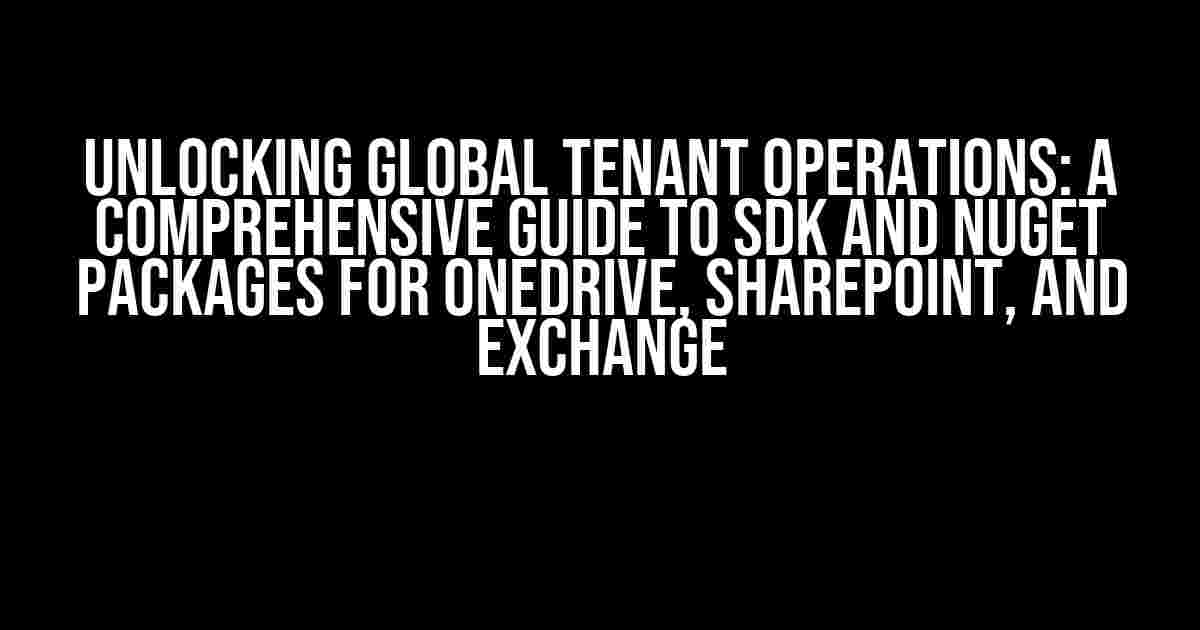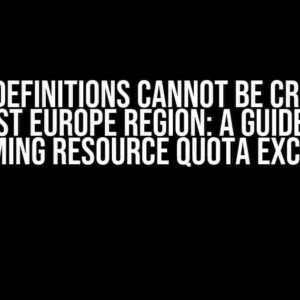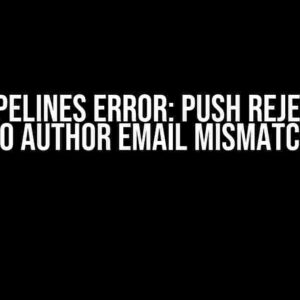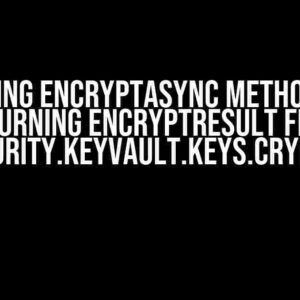Are you tired of sifting through endless documentation and Stack Overflow threads searching for the perfect SDK or NuGet package for your OneDrive, SharePoint, and Exchange integration? Look no further! In this article, we’ll take you on a journey to explore the best SDK and NuGet packages for global tenant operations, saving you time and effort in the process.
Why Do I Need SDK and NuGet Packages?
As a developer, you’re likely familiar with the complexities of integrating Microsoft services into your application. OneDrive, SharePoint, and Exchange are powerful tools that can revolutionize your workflow, but without the right tools, you’ll be stuck in a sea of API calls and authentication woes.
SDK and NuGet packages provide a convenient and efficient way to interact with these services, streamlining your development process and reducing the risk of errors. By leveraging these packages, you can focus on building a robust and scalable application that meets your users’ needs.
OneDrive SDK and NuGet Packages
OneDrive is an integral part of Microsoft’s productivity suite, offering a robust file storage and management system. To tap into its full potential, you’ll need the right SDK and NuGet packages.
Microsoft.OneDrive.Sdk: This NuGet package provides a comprehensive set of APIs for interacting with OneDrive, including file upload, download, and management.Microsoft.Graph.OneDrive: This SDK offers a more extensive range of features, including support for Microsoft Graph, which enables access to OneDrive files and folders.
Install-Package Microsoft.OneDrive.Sdk Install-Package Microsoft.Graph.OneDrive
SharePoint SDK and NuGet Packages
SharePoint is a powerful collaboration platform that enables teams to work together more effectively. To integrate SharePoint into your application, you’ll need the following SDK and NuGet packages:
Microsoft.SharePoint.Client: This NuGet package provides a comprehensive set of APIs for interacting with SharePoint, including site and list management, as well as file and folder operations.Microsoft.SharePoint.Online.CSOM: This SDK offers a more extensive range of features, including support for SharePoint Online and on-premises deployments.
Install-Package Microsoft.SharePoint.Client Install-Package Microsoft.SharePoint.Online.CSOM
Exchange SDK and NuGet Packages
Exchange is a robust email platform that enables teams to communicate more effectively. To integrate Exchange into your application, you’ll need the following SDK and NuGet packages:
Microsoft.Exchange.WebServices: This NuGet package provides a comprehensive set of APIs for interacting with Exchange, including email and calendar operations.Microsoft.Graph.Exchange: This SDK offers a more extensive range of features, including support for Microsoft Graph, which enables access to Exchange data.
Install-Package Microsoft.Exchange.WebServices Install-Package Microsoft.Graph.Exchange
Global Tenant Operations: What You Need to Know
When working with OneDrive, SharePoint, and Exchange, it’s essential to understand the concept of global tenant operations. This refers to the ability to access and manage resources across multiple tenants, enabling a more comprehensive and integrated experience.
To achieve global tenant operations, you’ll need to:
- Register your application with Azure Active Directory (AAD) to obtain an OAuth 2.0 token.
- Use the obtained token to authenticate with the respective Microsoft service (OneDrive, SharePoint, or Exchange).
- Utilize the SDK and NuGet packages listed above to interact with the service.
Authenticating with Azure Active Directory
To authenticate with Azure Active Directory, you’ll need to:
using Microsoft.Identity.Client;
var app = ConfidentialClientApplicationBuilder.Create(ClientId)
.WithClientSecret(ClientSecret)
.WithTenantId(TenantId)
.Build();
var tokenAcquisitionResult = await app.AcquireTokenSilentAsync(scopes);
var accessToken = tokenAcquisitionResult.AccessToken;
Configuring Your Application
To configure your application for global tenant operations, you’ll need to:
using Microsoft.SharePoint.Client;
using Microsoft.Exchange.WebServices;
var spContext = new SharePointContext("https://contoso.sharepoint.com");
var oneDriveClient = new OneDriveClient("https://contoso-my.sharepoint.com", accessToken);
var exchangeClient = new ExchangeClient("https://contoso.exchange.com", accessToken);
Best Practices for SDK and NuGet Package Management
When working with SDK and NuGet packages, it’s essential to follow best practices to ensure a seamless and efficient development experience.
- Keep your packages up-to-date: Regularly check for updates to ensure you have the latest features and bug fixes.
- Use the correct package versions: Ensure you’re using the correct package versions for your project to avoid compatibility issues.
- Test thoroughly: Test your application thoroughly to ensure the SDK and NuGet packages are working as expected.
Conclusion
In conclusion, integrating OneDrive, SharePoint, and Exchange into your application can be a daunting task, but with the right SDK and NuGet packages, you can unlock a world of possibilities. By following the instructions and best practices outlined in this article, you’ll be well on your way to achieving global tenant operations and creating a robust and scalable application that meets your users’ needs.
Remember to stay up-to-date with the latest developments and updates to the SDK and NuGet packages, and don’t hesitate to reach out to the Microsoft community for support and guidance.
| SDK/NuGet Package | Description | Install Command |
|---|---|---|
| Microsoft.OneDrive.Sdk | OneDrive SDK | Install-Package Microsoft.OneDrive.Sdk |
| Microsoft.Graph.OneDrive | Microsoft Graph OneDrive SDK | Install-Package Microsoft.Graph.OneDrive |
| Microsoft.SharePoint.Client | SharePoint Client SDK | Install-Package Microsoft.SharePoint.Client |
| Microsoft.SharePoint.Online.CSOM | SharePoint Online CSOM SDK | Install-Package Microsoft.SharePoint.Online.CSOM |
| Microsoft.Exchange.WebServices | Exchange Web Services SDK | Install-Package Microsoft.Exchange.WebServices |
| Microsoft.Graph.Exchange | Microsoft Graph Exchange SDK | Install-Package Microsoft.Graph.Exchange |
Frequently Asked Question
Are you tired of searching for the right SDK or Nuget packages for OneDrive, SharePoint, and Exchange? Look no further! Here are some answers to your most pressing questions.
What is the best SDK for OneDrive global tenant operations?
The Microsoft Graph SDK is the way to go for OneDrive global tenant operations. It provides a unified API endpoint for accessing Microsoft services, including OneDrive. With the Graph SDK, you can authenticate and authorize users, access files and folders, and perform various operations on OneDrive.
How do I authenticate with SharePoint using a Nuget package?
You can use the SharePoint.Client Nuget package to authenticate with SharePoint. This package provides a set of APIs for interacting with SharePoint sites and lists. To authenticate, you’ll need to register your application with Azure AD, obtain a client ID and secret, and then use the ClientContext class to authenticate with SharePoint.
What is the recommended SDK for Exchange global tenant operations?
The Exchange Web Services (EWS) Managed API is the recommended SDK for Exchange global tenant operations. This API provides a set of managed classes for interacting with Exchange, including sending emails, creating appointments, and accessing contacts.
Can I use a single Nuget package for both SharePoint and OneDrive operations?
Yes, you can use the Microsoft.Graph Nuget package to interact with both SharePoint and OneDrive. This package provides a unified API for accessing Microsoft services, including SharePoint and OneDrive. However, be aware that some SharePoint-specific functionality may not be available through the Graph API.
Are there any licensing restrictions for using these SDKs and Nuget packages?
Yes, there may be licensing restrictions for using these SDKs and Nuget packages, especially if you’re building a commercial application. Be sure to review the licensing terms and conditions for each SDK and Nuget package to ensure you’re complying with Microsoft’s requirements.




